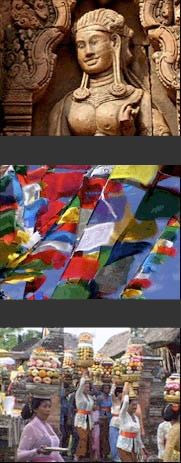The Yatra Trilogy: Visual Pilgrimage Mary Talbot Tricycle, The Buddhist Review From the earliest images of the Buddha's footprint to the gargantuan statues of Southeast Asia to the awe-inspiring intricacy of Tibetan mandalas, dharma imagery has inspired humans to stick to the path. So it seems only natural that the digital age would bring us digital aids for practice meant to inspire authentic devotion in the same spirit as seventeenth-century Laotian wood-carving of the Buddha's hand. Such is the motive behind The Yatra Trilogy, three fims directed, written and produced by John Bush. A longtime Buddhist, Bush set out to document his own pilgrimage (Yatra is the Sanskrit word for "sacred journey") through Asia for the benefit of as many people as possible. Bush is no newcomer to pilgrimage. A practitioner for more than thirty years, he studied with Buddhist teachers in the three main schools of Buddhism - Theravada masters S.N. Goenka and Anagarika Munindra, Tibetan lamas Chogyam Trungpa Rinpoche and Kalu Rinpoche, and Zen master Joshu Sasaki Roshi - as well as with the Hindu master Neem Karoli Baba. "I feel like I've eaten a very big meal and now it's time to digest," Bush says of his practice. Bush lived in India in the early 1970's, and later traveled to Asia as the cofounder and CEO of Illuminations, Inc., a spiritual-gift company that won awards for innovative designs and ethical business practices. "I learned about the process of yatra in India," he says, "where every moment of the journey has the possibility of revealing something." On this yatra, Bush didn't sit down to meditate. "I was using the lens to open up to what was there. The filming was its own meditation. Operating the camera was devotional practice." Bush is a gifted cinematographer, and the three movies layer gorgeous footage of pilgrimage sites, religious festivals, city life, and monastic rites over traditional and contemporary sacred music (the latter provided by David Hykes with The Harmonic Choir). An elegant narrative runs throughout, charting the geographical, historical, and metaphysical course of the dharma. "I wanted to create a new kind of viewing experience that would allow someone to have a direct encounter with these sacred spaces," says Bush. "They have their own presence, and I wanted to let them speak for themselves." Dharma River: Journey of a Thousand Buddhas, courses through Laos, Thailand and Burma. The Buddha's metaphor of crossing the river of samsara to liberation is the leitmotif, as the camera literally takes us through Bangkok's canals, down Burma on the Irawaddy, and across the great Mekong River. The narration describing the opulent temples and art of the region tells the story of Buddhism. The large gilded Buddha effigies in Thailand, for example, "are a brilliant vehicle, reflecting [the worshipper's] innate perfection... Empty inside, [they] represent the absence of a solid and opaque self." As the camera floats before images of the elongated earlobes of Burmese Buddhas, the narrator explains how Shakyamuni's "deformity" came from wearing the heavy earrings of a prince. Those pendulous ears continue to remind devotees to this day of our own deformities: greed, anger, delusion, attachment. Prajna Earth: Journey into Sacred Nature is a tour of Cambodia, Bali, and Java, cultures where Buddhism mingled with Hinduism and deep-rooted local animist traditions that view all of nature as a sacred landscape. Actress Sharon Stone's clean, unaffected narration of Prajna Earth complements Bush' gentle camera work. In Cambodia he lingers over the endless bas-reliefs, Buddhas, and temple enclosures at Angkor Wat, where a group of monastics are gathering for a retreat. In Java, we explore Borobodur, the largest Buddhist temple complex in the world, abandoned just one hundred years after its completion in the tenth century. Bush also succeeds in displaying the exquisite, round-the-clock Balinese veneration of Hindu, Buddhist, and animist spirits more effectively than any filmmakers since Lawrence and Lorne Blair, who produced the Ring of Fire film series in the 1970s. In Vajra Sky Bush takes his audience to central Tibet to witness the colossal destruction of Buddhist monuments - as well as the profound endurance of faith - under Chinese occupation. We visit the holy sites around Shigatse and Gyantse, watch as monks cover a mountainside with a massive thangka, and explore the bizarre Communist conversions of The Dalai Lama's ancestral palaces, the Potala and Norbulingka. The Yatra Trilogy offers up the mesmerizing beauty and ineffable power of places most of us will never see. "I was visiting many of these sites for the first time and the viewer is seeing them through my eyes," says Bush. "The fact is, they're part of the world's cultural heritage. It's important, even at this late date, to archive these things, to capture and share them." The movies have the unhurried pace and enveloping atmosphere of a real journey. Because Bush designed the DVD version (the series is available in VHS format as well) so that the viewer can turn off the narration, leaving just visuals and music, its possible to walk away with a sense of really having been there. It's a viewing experience that can be summed up by the narrator's description of the dazzling art in the Buddhist temples of Southeast Asia: "Beyond the grandiosity of religion, a deeper significance emerges. The opulence is a stratagem. One uses the exultation of the senses to go beyond the limits of the sense realm." A DVD may be sensory indulgence, but The Yatra Trilogy takes the viewer way beyond that.
|
 |